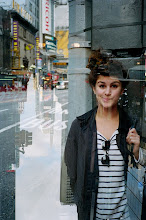Chasing the Velvet Underground
One of Mark Pearson's worksCertain artistic movements can and do promote lifestyles shaped around drugs. The youth of the '60s and '70s were particularly enamored with artists, musicians and writers, as there were not nearly as many exciting watering grounds for like-minded hipsters as there are today.
One young person of that generation was 53-year-old Mark Pearson, now a successful London artist. His longing to be part of the 'popist', Andy Warhol scene eventually led to a heroin addiction. By the time he was 20 he was using the drug recreationally, but heavily, and continued to do so on and off until the age of 28.
While we hear so much about artists that reach their demise through drugs, there are those with the drive to overcome their addiction, such as Mark Pearson.
In search of Hedonism
The London that Pearson grew up in was grey and dreary. According to him the only club anyone went to was Global Village (now Heaven). Because there was little to do here, he and his friends would create their own activities, trying to emulate their artistic heroes of New York, often with drugs at the centre. Pearson found that he could slip in and out of society with ease, giving him the freedom in a: “world with no adults” to experiment with drugs unnoticed.
For Pearson, the world of The Velvet Underground and The Factory was too enticing to ignore. Though separated by an ocean, the youth of this generation identified almost obsessively with that particular scene.
"There was nothing part-time about it. The boat was leaving and I was going to get on it. That was it and I didn't really expect to get off the boat. It was that passionate. The whole lifestyle - partying, The Factory, having this fantastic, experimental life. It was either that or a squat in Cold Harbour Lane (Camberwell)."
Pearson came, like much of the working class youth at the time, from an unartistic family who did not understand him, the majority of whom went on to work as dockers.
"I just thought what the fuck is that about, when there are all these fantastic things you can be, and you can get fucked and be cool? It was just another world. There was nothing they (the family) could give me that was going to help me to the place I wanted to get."
Addictions grip
At the age of 23, after his degree at Royal Academy of Art, Pearson went to New York in search of the Andy Warhol-Velvet Underground scene, which by then was petering out. During his time there, though, cocaine was the drug of choice as opposed to heroin. After all these years he still says it was worth it. “I met Andy Warhol. I did get there. And I did get involved in it all.”
However, after returning to London, Pearson’s use of heroin developed from being stylish, to an addiction. Much of his time was spent in squats and he and his friends turned to crime to afford the habit.
He paints a very dark picture of life at that time, describing waking up to dead bodies on the floor around him and the “bad things” people were driven to do.
“Everyone was getting arrested. We were really doing a lot of crime… Once you’re into that junkie mentality, you need the drug so much that you just don’t give a shit. My best mate O.D’d, twice actually. One week we saved him, then the next week he was gone.”
Unlike so many drug addicts, Pearson luckily realised that he couldn’t continue like this: “I just got to the level where I knew that I had to survive. I had to get off it. I was living on Frosties. There were murders where I was. It was getting really heavy; it was dark. What had been interesting was just getting horrible. It was getting dangerous.”
Mark carried on his art all through the years of drug taking. It neither hindered nor helped his work. He was experimental but had no interest in selling anything until later in life. “If you’re still driven and you still have an idea of what you want your life to be like, then you’ve got more of a chance of escaping.”
He says that the dangers of heroin and its fatal addictive quality that we are all aware of today had not been identified by the 1970s. People would use it recreationally and think nothing of it, just as people used opium in the 1920s. It was not until British anti-heroin campaigns in the late '80s that people were officially alerted to its dangers.
By the time ecstacy and the rave scene had been established, Mark had a daughter, Lucy, and was straight. He started selling work and is now an established London artist. He has a liberal attitude towards drugs now and he is one of the most interesting and sweetest people you could hope to meet.
http://www.artslondonnews.co.uk/20091124_mark-pearson

No comments:
Post a Comment